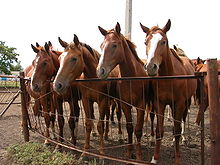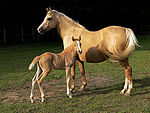- Budyonny horse
-
Budyonny 
Young Budyonny stallions in RussiaAlternative names Budenny
Budjonny
Budonny
BudennovskyCountry of origin Southern Russia Horse (Equus ferus caballus) The Budyonny is a breed of horse from Russia. They were developed for use as a military horse following the Russian Revolution and are currently used as an all-purpose competition horse and for driving.
Contents
Breed Characteristics
Conformation
The Budonny breed generally stands between 16 and 16.3hh,[1] and is generally chestnut with a golden sheen, although they may also be bay, gray or black. They have a well-proportioned head with a straight profile, a long neck, pronounced withers, sloping shoulders, a wide, deep chest, a long, straight back, and a slightly sloping croup. Their legs are long and strong with good joints and well-formed hooves.[2] The modern horse has a strong build, good bone, and are quite similar to the Thoroughbred. Conformation problems include occasional offset cannon bones in the forelegs and overly straight hind legs.[3]
Sub-categories
In the beginning, “Massive,” “Eastern,” and “Middle” types of the breed were recognized.
- The Massive type was large and somewhat rough. They were sturdy, with a well-developed bone structure, and those with an oriental typiness were especially prized. Their robust constitution made them specially suitable for herd keeping. They were used mainly for carriage driving.
- The Oriental type was lighter and more elegant. Generally chestnut with a gold sheen or bay, they were more demanding in the feed and management conditions they required.
- The Medium type was fairly large and well-muscled, but also rangy and athletic. They were faster than the other two types, and looked more like the Thoroughbred type.[4]
Later, demand for competition horses led to the creation of a single type with a larger proportion of Thoroughbred blood. This breed is of interest because it is the result of the complex state-sponsored cross-breeding programs that were implemented after the Russian Revolution and are still in place today. The Budyonny is bred today in the Ukraine and in the Kazakh and Kirghiz republics in the southern part of the former USSR.[3]
History
The Budyonny was named after Marshall Semyon Budyonny, a Bolshevik cavalry commander who became famous during the Russian Revolution. The breed was created by Budyonny, a well-known horse breeder himself, in the early 1920s in the Rostov region of Russia with the intent of producing cavalry horses to replace those lost during and after World War I. The resulting horses were used in Russian cavalry divisions during World War II and after.
Budyonnys were bred from a cross of local Don and Chernomor mares and Thoroughbred stallions. The Chernomor (also known as the Tchernomor or the Cherkassky) is a type of Cossack horse similar to the Don, although smaller. They are descendents of the horses raised by Zaporozhian Cossacks, and were first bred around Krasnodar, north of the Caucasus Mountains. During the first round of breeding for the Budyonny horse, blood from Kirghiz and Kazakh horses was also used, but the progeny was found to be not as hardy or conformationally sound, and later the Budyonny was used to improve these two breeds.
The first Budyonny horses were known as Anglo-Dons, and the best were inter-bred, with the foundation stock for the Budyonny selected from their offspring. The foundation stock consisted of 657 mares of Anglo-Don, Anglo-Chernomor, and Anglo-Don/Chernomor crosses. These mares were crossed with Anglo-Don and Thoroughbred stallions. The broodmares were given the best of care with feed and management. The young stock, when between two and four years old, were tested for performance on the racecourse and in cavalry equitation courses. In 1949 the breed was officially recognized.[3]
In the 1950s an experiment was performed to gauge the ability of the Budyonny breed to adapt to harsh conditions without human help. A number of horses were turned loose on a large island in Manych Lake in the Rostov district. The horses have since survived and thrived, proving that they are capable of living in the wild for extended periods without human assistance.[5]
Uses
The Budyonny is used as an all-round competition horse, competing in dressage, steeplechasing, three-day eventing, and endurance. The breed is fast, agile, and enduring, which allows them to be used for many different events.[3] They are also used as light carriage horses.[5]
References
- ^ "Troyka". http://www.horses.ru/budenny.htm. Retrieved 2009-08-24.
- ^ Bongianni, Maurizio (1988). Simon & Schuster's Guide to Horses and Ponies. Simon & Schuster, Inc.. p. 52. ISBN 0-671-66068-3.
- ^ a b c d "Budenny". My Pets. http://www.mypets.net.au/flex/budenny_horse/581/1. Retrieved December 28, 2008.
- ^ "The Budenny". Equiworld. http://www.equiworld.net/horses/horsecare/Breeds/budenny/index.htm. Retrieved 2011-01-04.
- ^ a b "Budyonny". Oklahoma State University. http://www.ansi.okstate.edu/breeds/horses/budyonny/. Retrieved December 28, 2008.
External links
Equine Equine science and
management
Equestrianism
and sportGlossary of equestrian terms · List of Equestrian Sports · Horse tack · Bit · Bridle · Saddle · Harness · English riding · Western riding · Driving · Horse training · Horse racing · Equestrian at the Summer Olympics (medalists, venues) · Horse show · EquitationEvolution and history Domestication · In warfare · In the Middle Ages · Horses in East Asian warfare · History of the horse in South Asia · Horses in the Napoleonic Wars · Horses in World War I · Horses in World War II · History of the horse in BritainHorse breeds, types
and other EquidaeList of horse breeds · Wild horse · Feral horse · Stock horse · Gaited horse · Draft horse · Warmblood · Sport horse · List of horse breeds in DAD-ISOther EquusHybridsCategories:- Horse breeds
- Horse breeds originating in Russia
Wikimedia Foundation. 2010.
